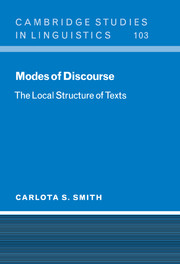Book contents
- Frontmatter
- Contents
- Preface
- Introduction
- PART I DISCOURSE STRUCTURE
- 1 The study of discourse
- 2 Introduction to the Discourse Modes
- 3 Text representation and understanding
- PART II LINGUISTIC ANALYSIS OF THE DISCOURSE MODES
- PART III SURFACE PRESENTATIONAL FACTORS
- PART IV DISCOURSE MODES AND THEIR CONTEXT
- Appendix A The Texts
- Appendix B Glossary
- References
- General index
- Index of names
1 - The study of discourse
Published online by Cambridge University Press: 18 June 2010
- Frontmatter
- Contents
- Preface
- Introduction
- PART I DISCOURSE STRUCTURE
- 1 The study of discourse
- 2 Introduction to the Discourse Modes
- 3 Text representation and understanding
- PART II LINGUISTIC ANALYSIS OF THE DISCOURSE MODES
- PART III SURFACE PRESENTATIONAL FACTORS
- PART IV DISCOURSE MODES AND THEIR CONTEXT
- Appendix A The Texts
- Appendix B Glossary
- References
- General index
- Index of names
Summary
This book studies discourse passages from a linguistic point of view. Discourse is made up of sentences, and through linguistic analysis we have learned a good deal about them. The perspective of linguistics, however, can't be used directly to study an entire discourse. Novels, histories, arguments, and other types of discourse are activities with their own character and conventional structure. Receivers draw on discourse knowledge to construct interpretations.
The first problem for the linguist interested in close study of discourse, then, is to find a fruitful level for analysis. Larger units are organized primarily by convention and expectation. I will work more locally, at the level of the passage. There are intuitive differences between the passages of a discourse. People recognize passages of several kinds, namely Narrative, Description, Report, Information, and Argument. The intuitions are linguistically based: the passages have a particular force and make different contributions to a text. They can be identified by characteristic clusters of linguistic features. I shall say that a passage of text with certain features realizes a particular “Discourse Mode.” The Discourse Mode is appropriate for close linguistic analysis, because at this level linguistic forms make a difference. Discourse Modes appear in texts of all types of activity, or genres. I use the terms “discourse” for spoken and written material; “text” for written material.
The Discourse Modes constitute an interesting level of text structure. I analyze them in two ways. I first discuss the differences between text passages of each mode.
- Type
- Chapter
- Information
- Modes of DiscourseThe Local Structure of Texts, pp. 7 - 21Publisher: Cambridge University PressPrint publication year: 2003



